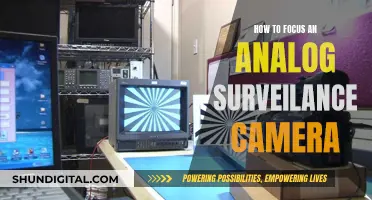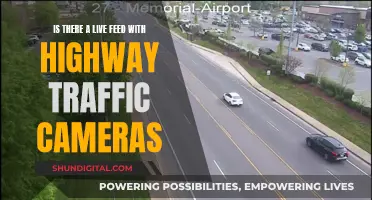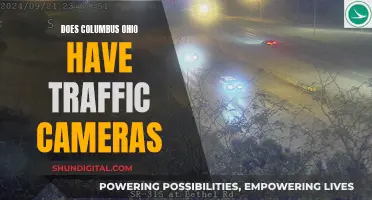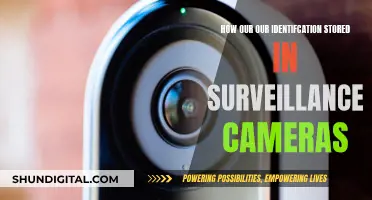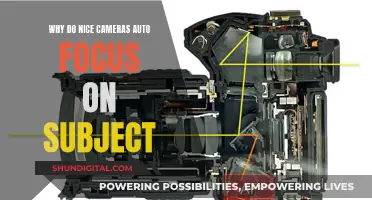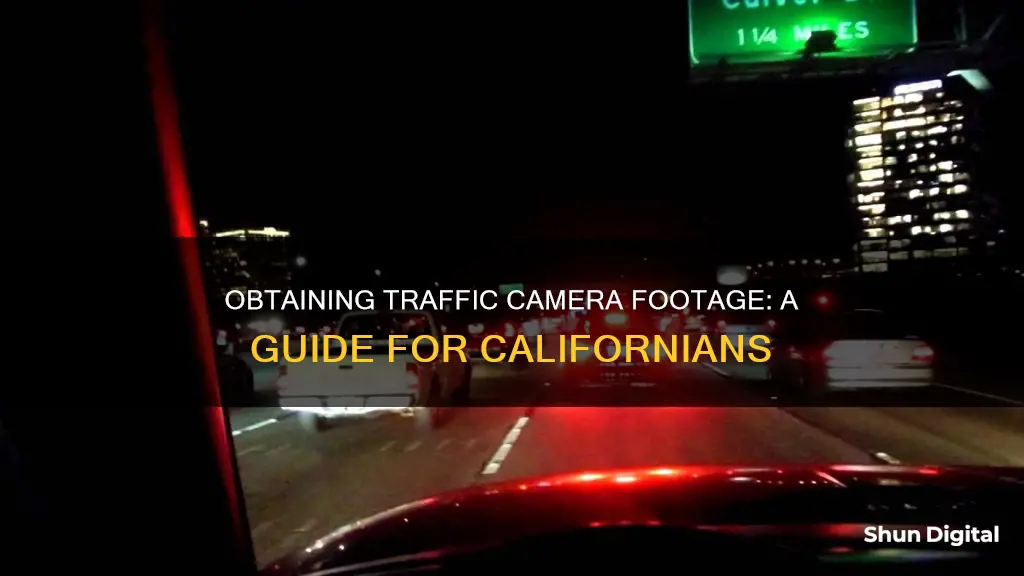
Traffic camera footage can be crucial in determining the cause of a car accident and holding the responsible party accountable. In California, the best way to obtain this footage is to promptly contact the California Department of Transportation or local law enforcement agencies. However, this process can be complex and frustrating, and the footage is typically retained for a limited period, so it is important to act quickly. This paragraph will discuss the steps to take to obtain traffic camera footage in California, the challenges that may be faced, and the potential benefits of having this evidence.
| Characteristics | Values |
|---|---|
| How to obtain traffic camera footage in California | Contact the California Department of Transportation or local law enforcement agencies. Submit a formal request and comply with any legal procedures or fees involved. |
| How long is traffic camera footage stored? | Typically, traffic camera footage is stored for 30 to 90 days before being deleted or overwritten. However, in some jurisdictions, like Los Angeles, footage may be stored for up to five years. |
| Jurisdictional guidelines | Justify invasion of privacy for security or business purposes with a reasonable expectation of privacy. Recording or eavesdropping on confidential communication is forbidden (California Penal Code Sec. 632). Obtain footage through a request or subpoena based on the owning organization's policy. Consent is required for audio recording, and advance permission is needed for recording in a courtroom. |
| Other sources of footage | Security cameras, personal devices, dashcams, and witness recordings. |
What You'll Learn

Identify the location of the traffic camera
To identify the location of a traffic camera in California, you can use a live traffic camera map. These maps show the location of each traffic camera that is up and running in California. The cameras are usually placed on highways, freeways, parkways, or major roads and intersections.
- The California Traffic Camera System: This map shows the location of traffic cameras across California. On the map, camera icons with a plus or minus sign indicate whether the camera has a video feed or only captures images. Clicking on a camera icon will bring up a still image of the intersection, and you may be able to access a live video feed.
- PhotoEnforced.com: This website is an open database of red-light camera locations across the United States, including California. While it does not operate the cameras, it provides information on their locations. Red-light cameras are typically located on the side or corner of an intersection.
- Caltrans Streaming Video Locations: Caltrans provides a table of links to live traffic cameras for various routes in California. The routes are listed in order, starting from the southernmost or westernmost camera location.
In addition to these resources, there are also city-specific traffic camera maps and websites, such as the one mentioned for Los Angeles, California. These can be found by searching for the relevant city or region followed by "live traffic cameras."
AI Camera Mode: How Does It Work?
You may want to see also

Determine the jurisdiction of the camera
Once you have identified the location of the traffic camera, the next step is to determine the jurisdiction of the camera. This is crucial because it will determine who you need to contact to obtain the video footage.
Traffic cameras in California can be operated by either the local police department, the Department of Transportation, or a private company. The California Department of Transportation (Caltrans) has installed Closed-Circuit Television Cameras on many freeways in urban areas. The images captured by these cameras are transmitted to Regional Transportation Management Centers across the state, where they are used to verify reported incidents and dispatch the appropriate response. It is important to note that these cameras are strictly used for traffic management purposes and not for law enforcement or issuing traffic tickets. Additionally, Caltrans does not record or save the camera footage.
If the camera is operated by the local police department or the Department of Transportation, you will need to contact the relevant government agency to request the footage. On the other hand, if the camera is operated by a private company, you will need to contact that company directly to obtain the footage.
It is worth mentioning that, in California, automated enforcement systems can only be operated by a government agency in cooperation with a law enforcement agency. This is to ensure transparency and public scrutiny of the policies and procedures employed by the government agency. However, it has been noted that some automated enforcement systems in California are operated by private corporations, which is illegal under the state's vehicle code.
Focusing Your Luma Camera: The Ultimate Guide
You may want to see also

Contact the relevant agency
To obtain traffic camera footage in California, you must contact the relevant agency. This could be the California Department of Transportation, local law enforcement agencies, or the private company operating the camera.
First, identify the location of the traffic camera. This can be done by reviewing the police report or contacting the local police department or department of transportation. Once you know the location, you need to determine the jurisdiction of the camera. Is it operated by the local police, the department of transportation, or a private company? This information will tell you who to contact for the footage.
When you have identified the appropriate agency, contact them to request the video footage. Provide as many details as possible about the accident, including the date, time, and location. Be persistent but polite in your follow-up calls or emails. Some agencies may require a release form or charge a fee for providing the footage, so be sure to ask about any requirements or costs in advance.
If the traffic camera is managed by a private company, contact them directly to request the footage. They may have specific procedures for releasing the footage, so follow their instructions carefully.
It is important to act quickly, as traffic camera footage is typically retained for a limited period, usually between 30 and 90 days, before being deleted or overwritten. In some jurisdictions, like Los Angeles, traffic camera footage may be stored for up to five years.
Car Camera Theft: What to Do?
You may want to see also

Submit a formal request
To obtain traffic camera footage in California, you must submit a formal request. This process can be complex and frustrating, but it is essential if you need the footage for legal purposes or to determine the cause of an accident. Here is a detailed guide on submitting a formal request:
Identify the Location and Jurisdiction of the Traffic Camera:
First, you need to identify the specific traffic camera that captured the footage you require. This can be done by reviewing police reports or contacting the local police department or the Department of Transportation. Once you've identified the camera's location, determine whether it is operated by the local police, the Department of Transportation, or a private company, as this will dictate who you need to contact to obtain the footage.
Contact the Appropriate Agency:
After determining the jurisdiction of the camera, contact the relevant agency to request the footage. This may be the local police department, the Department of Transportation, or a private company. Be prepared to provide details about the incident, including the date, time, and location, to facilitate their search.
Follow Up on Your Request:
After making the initial request, follow up to ensure it is being processed. Be persistent yet polite in your enquiries. Some agencies may require you to provide a release form before releasing the footage, stating that it will only be used for personal purposes. Additionally, some agencies may charge a fee for providing the footage, so enquire about any fees beforehand.
Comply with Legal Procedures and Privacy Laws:
When obtaining and using traffic camera footage, it is crucial to comply with all legal requirements and privacy laws. Ensure you understand the jurisdictional guidelines in California, which may include justifying the invasion of privacy and obtaining consent for audio recordings. Respect any privacy laws that may restrict access to certain footage.
Act Quickly:
Keep in mind that traffic camera footage is typically retained for a limited period, ranging from a few days to several weeks or months, depending on the specific jurisdiction and camera system. In Los Angeles, for example, traffic camera footage is stored for up to five years. Therefore, it is essential to act promptly to increase your chances of successfully obtaining the footage before it is deleted or overwritten.
Action Cameras: Focusing on the Adventure
You may want to see also

Comply with legal procedures and privacy laws
To comply with legal procedures and privacy laws when obtaining traffic camera footage in California, it is important to understand the relevant laws and regulations. Here are some key considerations:
- Invasion of Privacy: According to California law, there must be a justification for invading privacy, such as for security or business purposes, and it must be reasonable. This applies to both public and private spaces.
- Recording Confidential Communication: It is forbidden under California Penal Code Sec. 632 to record or eavesdrop on confidential conversations without the consent of all parties involved. This includes audio recordings made by surveillance cameras.
- Consent for Audio Recording: California is a "two-party consent" state, which means that explicit consent is required from all parties before recording any audio.
- Courtroom Recordings: Recording inside a courtroom requires advance permission from a judge.
- Jurisdictional Guidelines: The laws and guidelines regarding traffic camera footage may vary depending on the jurisdiction within California. It is important to understand the specific regulations in the relevant area.
- Retention Policies: Traffic camera footage is typically retained for a limited period, ranging from 30 to 90 days, before being deleted or overwritten. However, there may be exceptions, such as in Los Angeles, where footage is stored for up to five years.
- Compliance with Privacy Laws: Ensure that all requests and uses of the footage comply with state and federal privacy laws to avoid potential legal issues.
- Consult a Legal Professional: Obtaining traffic camera footage can be complex, and it is recommended to seek guidance from a lawyer or legal professional to ensure compliance with all relevant laws and regulations.
Olympus E-M5 II: How Many Shots Per Battery Charge?
You may want to see also
Frequently asked questions
The best way to obtain traffic camera footage in California is to first identify the location and jurisdiction of the camera, and then contact the relevant authority, such as the California Department of Transportation or local law enforcement agencies. You will then need to submit a formal request and comply with any legal procedures or fees involved.
The retention period for traffic camera footage can vary. Typically, footage is stored for 30 to 90 days before being deleted or overwritten. However, in some jurisdictions, such as Los Angeles, footage may be stored for up to five years.
Yes, if you are unable to obtain traffic camera footage, there are several other types of evidence that can be useful, such as photographs of the accident scene, witness testimonies, police reports, medical records, dashcam footage, and cell phone records.


